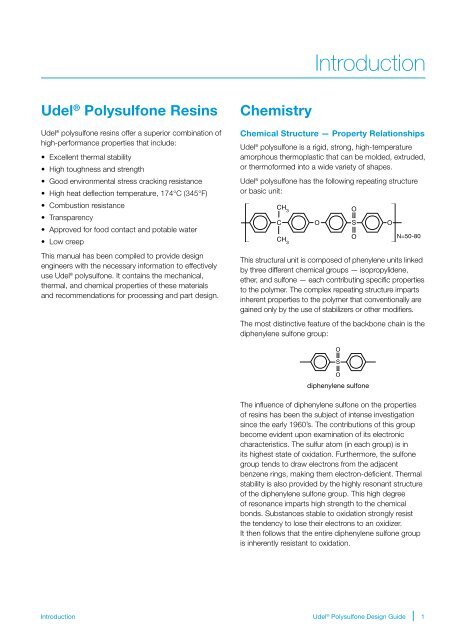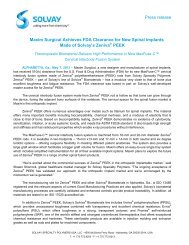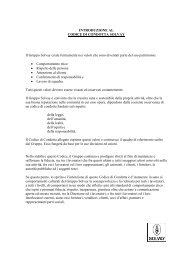Design Guide - Solvay Plastics
Design Guide - Solvay Plastics
Design Guide - Solvay Plastics
You also want an ePaper? Increase the reach of your titles
YUMPU automatically turns print PDFs into web optimized ePapers that Google loves.
Introduction<br />
Udel ® Polysulfone Resins<br />
Udel ® polysulfone resins offer a superior combination of<br />
high-performance properties that include:<br />
• Excellent thermal stability<br />
• High toughness and strength<br />
• Good environmental stress cracking resistance<br />
• High heat deflection temperature, 174°C (345°F)<br />
• Combustion resistance<br />
• Transparency<br />
• Approved for food contact and potable water<br />
• Low creep<br />
This manual has been compiled to provide design<br />
engineers with the necessary information to effectively<br />
use Udel ® polysulfone. It contains the mechanical,<br />
thermal, and chemical properties of these materials<br />
and recommendations for processing and part design.<br />
Chemistry<br />
Chemical Structure — Property Relationships<br />
Udel ® polysulfone is a rigid, strong, high-temperature<br />
amorphous thermoplastic that can be molded, extruded,<br />
or thermoformed into a wide variety of shapes.<br />
Udel ® polysulfone has the following repeating structure<br />
or basic unit:<br />
CH 3<br />
C<br />
CH 3<br />
O<br />
O<br />
S<br />
O<br />
O<br />
N=50-80<br />
This structural unit is composed of phenylene units linked<br />
by three different chemical groups — isopropylidene,<br />
ether, and sulfone — each contributing specific properties<br />
to the polymer. The complex repeating structure imparts<br />
inherent properties to the polymer that conventionally are<br />
gained only by the use of stabilizers or other modifiers.<br />
The most distinctive feature of the backbone chain is the<br />
diphenylene sulfone group:<br />
O<br />
S<br />
O<br />
diphenylene sulfone<br />
The influence of diphenylene sulfone on the properties<br />
of resins has been the subject of intense investigation<br />
since the early 1960’s. The contributions of this group<br />
become evident upon examination of its electronic<br />
characteristics. The sulfur atom (in each group) is in<br />
its highest state of oxidation. Furthermore, the sulfone<br />
group tends to draw electrons from the adjacent<br />
benzene rings, making them electron-deficient. Thermal<br />
stability is also provided by the highly resonant structure<br />
of the diphenylene sulfone group. This high degree<br />
of resonance imparts high strength to the chemical<br />
bonds. Substances stable to oxidation strongly resist<br />
the tendency to lose their electrons to an oxidizer.<br />
It then follows that the entire diphenylene sulfone group<br />
is inherently resistant to oxidation.<br />
Introduction<br />
Udel ® Polysulfone <strong>Design</strong> <strong>Guide</strong><br />
1
















